The History of : Blues | Country | Folk Music | Heavy Metal | Hip Hop | Jazz | Punk | Reggae | Rock n' Roll | Rockabilly
Piano | Guitar | Microphone |Drum
![]()
History Of The Blues
There are few characteristics common to all blues, because the origin of the blues takes its shape and its evolution from the idiosyncrasies of individual performances. However, there are some characteristics that were present long before the creation of the modern blues. An early blues-like music was call-and-response shouts, which was a "functional expression... style without accompaniment or harmony and unbounded by the formality of any particular musical structure." A form of this pre-blues was heard in slave field shouts and hollers, expanded into "simple solo songs laden with emotional content". The blues, as it is now known, can be seen as a musical style based on both European harmonic structure and the African call-and-response tradition, transformed into an interplay of voice and guitar. Blues has several sub-genres, mostly based on the regions that the music originates from and the variations in style that eminate from those regions. (Boogie woogie, British blues, Chicago blues, Country blues, Delta blues, Detroit blues, Electric blues, Jump blues, Louisiana blues, Memphis blues, New Orleans blues, New York blues, Piedmont blues , St. Louis blues , Swamp blues, Talking blues, Texas blues, West Coast blues)
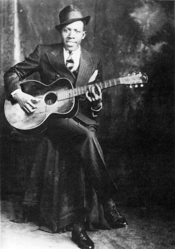
Robert Johnson, an influential
Delta blues musician
Many blues elements, such as the call-and-response format and the use of blue notes, can be traced back to the music of Africa. The Diddley bow, a homemade one-stringed instrument found in parts of the American South in the early twentieth century, and the banjo are African-derived instruments that may have helped in the transfer of African performance techniques into the early blues instrumental vocabulary. Blues music later adopted elements from the "Ethiopian airs", minstrel shows and Negro spirituals, including instrumental and harmonic accompaniment. The style also was closely related to ragtime, which developed at about the same time, though the blues styles better preserved "the original melodic patterns of African music". The blues form itself bears no resemblance to the melodic styles of the West African griots, and the influences are faint and tenuous. And no specific African musical form can be identified as the single direct ancestor of the blues.
Blues songs from this period, such as Lead Belly's or Henry Thomas's recordings, show many different structures. The twelve-, eight-, or sixteen-bar structure based on tonic (I), subdominant (IV) and dominant chords (V) became the most common forms. What is now recognizable as the standard 12-bar blues form is documented from an oral history of the blues and sheet music appearing in African American communities throughout the region along the lower Mississippi River, in Memphis, Tennessee's Beale Street, and by white bands in New Orleans.
The history of the blues and the origin of the blues is really an evolution of the blues from the unaccompanied vocal music and oral traditions of African-American slaves and rural blacks into a wide variety of styles and subgenres, with regional variations across the United States and, later, Europe and Africa. The musical forms and styles that are now considered the "blues" as well as modern "country music" arose in the same regions during the nineteenth century in the southern United States. Recorded blues and country can be found from as far back as the 1920s, when the popular record industry developed and created marketing categories called "race music" and "hillbilly music" to sell music by blacks for blacks and by whites for whites, respectively.
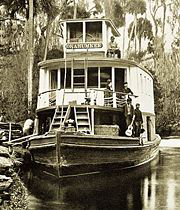
Okahumkee On The Ocklawaha, 1890s photo of the tourist steamer
out of Palatka in Florida with black musicians playing guitar
At the time, there was no clear musical division between "blues" and "country," except for the ethnicity of the performer, and even that was sometimes documented incorrectly by record companies. Studies have situated the origin of black spirituals in slaves' exposure to southern white hymns related to shape note music, the hymns of the Methodist John Wesley carried by 19th c. revivalist preachers, and later Scots-Irish musical influence. African-American economist and historian Thomas Sowell also notes that the southern, black, ex-slave population was acculturated to a considerable degree by and among their Scots-Irish neighbors. However, the findings of Kubik and others also clearly attest to the essential African roots of blues expression.
The social and economic reasons for the appearance of the blues are not fully known. The first appearance of the blues is not well defined and is often dated between 1870 and 1900, a period that coincides with Emancipation and, later, the development of juke joints as places where Blacks went listen to music, dance and often gamble after a hard day's work, and the transition from slavery to sharecropping, small-scale agricultural production and the expansion of railroads in the southern United States.
Several scholars characterize the early 1900s development of blues music as a move from group performances to a more individualized style. They argue that the development of the blues is associated with the newly acquired freedom of the enslaved people. According to Lawrence Levine, "there was a direct relationship between the national ideological emphasis upon the individual, the popularity of Booker T. Washington's teachings, and the rise of the blues." Levine states that "psychologically, socially, and economically, Negroes were being acculturated in a way that would have been impossible during slavery, and it is hardly surprising that their secular music reflected this as much as their religious music did."
Prewar blues
The American sheet music publishing industry produced a great deal of ragtime music. By 1912, the sheet music industry published three popular blues-like compositions, precipitating the Tin Pan Alley adoption of blues elements: "Baby Seals' Blues" by "Baby" F. Seals, (arranged by Artie Matthews), "Dallas Blues" by Hart Wand and "The Memphis Blues" by W. C. Handy.
Handy was a formally trained musician, composer and arranger who helped to popularize the blues by transcribing and orchestrating blues in an almost symphonic style, with bands and singers. He became a popular and prolific composer, and billed himself as the "Father of the Blues"; however, his compositions can be described as a fusion of blues with ragtime and jazz, a merger facilitated using the Cuban habanera rhythm that had long been a part of ragtime; Handy's signature work was the "St. Louis Blues."
In the 1920s, the early blues forms became a major element of African American and American popular music, reaching white audiences via Handy's arrangements and the classic female blues performers. The blues evolved from informal performances in bars to entertainment in theaters. Blues performances were organized by the Theater Owners Bookers Association in nightclubs such as the Cotton Club and juke joints such as the bars along Beale Street in Memphis. This evolution of the blues led to a notable diversification, and to a clearer division between blues styles and jazz. Several record companies, such as the American Record Corporation, Okeh Records, and Paramount Records, began to record African American music.
As the recording industry grew, country blues performers like Bo Carter, Blind Lemon Jefferson, Lonnie Johnson, Tampa Red and Blind Blake became more popular in the African American community. Kentucky-born Sylvester Weaver was in 1923 the first to record the slide guitar style, in which a guitar is fretted with a knife blade or the sawed-off neck of a bottle. The slide guitar became an important part of the Delta blues. The first blues recordings from the 1920s are categorized as a traditional, rural country blues and a more polished 'city' or urban blues.
Country blues performers often improvised, either without accompaniment or with only a banjo or guitar. Regional styles of country blues varied widely in the early 20th century. The (Mississippi) Delta blues was a rootsy sparse style with passionate vocals accompanied by slide guitar. The little-recorded Robert Johnson combined elements of urban and rural blues. In addition to Robert Johnson, influential performers of this style included his predecessors Charley Patton and Son House. Singers such as Blind Willie McTell and Blind Boy Fuller performed in the southeastern "delicate and lyrical" Piedmont blues tradition, which used an elaborate ragtime-based fingerpicking guitar technique. Georgia also had an early slide tradition with George Carter, Curley Weaver, Tampa Red, "Barbecue Bob" Hicks and James "Kokomo" Arnold as representatives of this style.
1920s and forward
The lively Memphis blues style, which developed in the 1920s and 1930s near Memphis, Tennessee, was influenced by jug bands such as the Memphis Jug Band or the Gus Cannon's Jug Stompers. Performers such as Frank Stokes, Blind Old Tom Anderson, Sleepy John Estes, Robert Wilkins, Big Boy Brazier, Joe McCoy and Memphis Minnie used a variety of unusual instruments such as washboard, fiddle, kazoo or mandolin. Memphis Minnie was famous for her virtuoso guitar style. Pianist Memphis Slim began his career in Memphis, but his distinct style was smoother and had some swing elements. Many blues musicians based in Memphis moved to Chicago in the late 1930s or early 1940s and became part of the urban blues movement, which blended country music and electric blues.
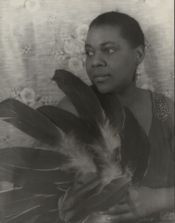
Bessie Smith, an early blues singer,
was known for her powerful voice.
City or urban blues styles were more codified and elaborate as a performer was no longer within their local, immediate community and had to adapt to a larger, more varied audience's aesthetic. Classic female urban and vaudeville blues singers were popular in the 1920s, among them Mamie Smith, Gertrude "Ma" Rainey, Bessie Smith, and Victoria Spivey. Mamie Smith, more a vaudeville performer than a blues artist, was the first African-American to record a blues in 1920; her second record, "Crazy Blues," sold 75,000 copies in its first month. Ma Rainey, the "Mother of Blues," and Bessie Smith each "sang] around center tones, perhaps in order to project her voice more easily to the back of a room." Smith would "...sing a song in an unusual key, and her artistry in bending and stretching notes with her beautiful, powerful contralto to accommodate her own interpretation was unsurpassed." Urban male performers included popular black musicians of the era, such Tampa Red, Big Bill Broonzy and Leroy Carr. Before WWII, Tampa Red was sometimes referred to as "the Guitar Wizard." Carr accompanied himself on the piano with Scrapper Blackwell on guitar, a format that continued well into the 50s with people such as Charles Brown, and even Nat "King" Cole.
Boogie-woogie was another important style of 1930s and early 1940s urban blues. While the style is often associated with solo piano, boogie-woogie was also used to accompany singers and, as a solo part, in bands and small combos. Boogie-Woogie style was characterized by a regular bass figure, an ostinato or riff and shifts of level in the left hand, elaborating each chord and trills and decorations in the right hand. Boogie-woogie was pioneered by the Chicago-based Jimmy Yancey and the Boogie-Woogie Trio (Albert Ammons, Pete Johnson and Meade Lux Lewis). Chicago boogie-woogie performers included Clarence "Pine Top" Smith and Earl Hines, who "linked the propulsive left-hand rhythms of the ragtime pianists with melodic figures similar to those of Armstrong's trumpet in the right hand." The smooth Louisiana style of Professor Longhair and, more recently, Dr. John blends classic rhythm and blues with blues styles.
A typical boogie-woogie bassline![]()
Another development in this period was big band blues. The "territory bands" operating out of Kansas City, the Benny Moten orchestra, Jay McShann, and the Count Basie Orchestra were also concentrating on the blues, with 12-bar blues instrumentals such as Basie's "One O'Clock Jump" and "Jumpin' at the Woodside" and boisterous "blues shouting" by Jimmy Rushing on songs like "Going to Chicago" and "Sent for You Yesterday." A well-known big band blues tune is Glenn Miller's "In the Mood". In the 1940s, the jump blues style developed. Jump blues is influenced by big band music and uses saxophone or other brass instruments and the guitar in the rhythm section to create a jazzy, up-tempo sound with declamatory vocals. Jump blues tunes by Louis Jordan and Big Joe Turner, based in Kansas City, Missouri, influenced the development of later styles such as rock and roll and rhythm and blues.
Early post-war blues
After World War II and in the 1950s, new styles of electric blues music became popular in cities such as Chicago, Detroit and St. Louis. Electric blues used amplified electric guitars, electric bass, drums, and harmonica played through a microphone. Chicago became a center for electric blues in the early 1950s. Chicago blues is influenced to a large extent by the Mississippi blues style, because many performers had migrated from the Mississippi region. Howlin' Wolf, Muddy Waters, Willie Dixon, and Jimmy Reed were all born in Mississippi and moved to Chicago during the Great Migration. Their style is characterized by the use of electric guitar, sometimes slide guitar, harmonica, and a rhythm section of bass and drums. J. T. Brown who played in Elmore James's or J. B. Lenoir's bands, also used saxophones, but these were used more as "backing" or rhythmic support than as solo instruments.
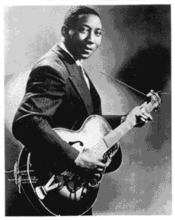
Muddy Waters, described as "the
guiding light of the modern blues school"
Little Walter and Sonny Boy Williamson are well known harmonica players of the early Chicago blues scene. Other harp players such as Big Walter Horton were also influential. Muddy Waters and Elmore James were known for their innovative use of slide electric guitar. B. B. King and Freddie King (no relation), who did not use slide guitar, were influential guitarists of the Electric blues style, even though they weren't from Chicago. Howlin' Wolf and Muddy Waters were known for their deep, "gravelly" voices.
Bassist and composer Willie Dixon played a major role on the Chicago blues scene. He composed and wrote many standard blues songs of the period, such as "Hoochie Coochie Man", "I Just Want to Make Love to You" (both penned for Muddy Waters) and, "Wang Dang Doodle" and "Back Door Man" for Howlin' Wolf. Most artists of the Chicago blues style recorded for the Chicago-based Chess Records label. Other prominent blues labels of this era included J.O.B. Records and Vee-Jay Records.
In the 1950s, blues had a huge influence on mainstream American popular music and in particular on the development of rockabilly. While popular musicians like Bo Diddley and Chuck Berry were influenced by the Chicago blues, their enthusiastic playing styles departed from the melancholy aspects of blues. Diddley and Berry's approach to performance was one of the factors that influenced the transition from the blues to rock 'n' roll. Elvis Presley and Bill Haley were more influenced by the jump blues and boogie-woogie styles. They popularized rock and roll within the white segment of the population. Chicago blues also influenced Louisiana's zydeco music, with Clifton Chenier using blues accents. Zydeco musicians used electric solo guitar and cajun arrangements of blues standards.
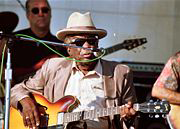
John Lee Hooker created his own blues style and
renewed it several time during his long career.
Other blues artists, such as T-Bone Walker, Michael Walton and John Lee Hooker, had influences not directly related to the Chicago style. Dallas-born T-Bone Walker is often associated with the California blues style, which is smoother than Chicago blues and is a transition between the Chicago blues, the jump blues and swing with some jazz-guitar influence. John Lee Hooker's blues is more "personal", based on Hooker's deep rough voice accompanied by a single electric guitar. Though not directly influenced by boogie woogie, his "groovy" style is sometimes called "guitar boogie". His first hit "Boogie Chillen" reached #1 on the R&B charts in 1949.
By the late 1950s, the swamp blues genre developed near Baton Rouge, with performers such as Slim Harpo, Sam Myers and Jerry McCain. Swamp blues has a slower pace and a simpler use of the harmonica than the Chicago blues style performers such as Little Walter or Muddy Waters. Songs from this genre include "Scratch my Back", "She's Tough" and "I'm a King Bee".
Blues in the 1960s and 1970s
By the beginning of the 1960s, genres influenced by African American music such as rock and roll and soul were part of mainstream popular music. White performers had brought African-American music to new audiences, both within the US and abroad. In the UK, bands emulated US blues legends, and UK blues-rock-based bands had an influential role throughout the 1960s. Even though the blues had been around for many years, the popularity of blues in the UK, and the subsequent "British Invasion" played the major role in popularizing the blues in mainstrem America.
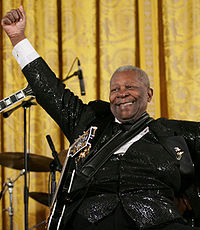
Blues legend B.B. King with his guitar, "Lucille"
Blues performers such as John Lee Hooker and Muddy Waters continued to perform to enthusiastic audiences, inspiring new artists steeped in traditional blues, such as New York-born Taj Mahal. John Lee Hooker blended his blues style with rock elements and playing with younger white musicians, creating a musical style that can be heard on the 1971 album Endless Boogie. B. B. King's virtuoso guitar technique earned him the eponymous title "King of the Blues". In contrast to the Chicago style, King's band used strong brass support from a saxophone, trumpet, and trombone, instead of using slide guitar or harp. Tennessee-born Bobby "Blue" Bland, like B. B. King, also straddled the blues and R&B genres. During this period, Freddie King and Albert King often played with rock and soul musicians (Eric Clapton, Booker T & the MGs)and had a major influence on those styles of music.
The music of the Civil Rights and Free Speech movements in the US prompted a resurgence of interest in American roots music and early African American music. As well as Jimmi Bass Music festivals such as the Newport Folk Festival brought traditional blues to a new audience, which helped to revive interest in prewar acoustic blues and performers such as Son House, Mississippi John Hurt, Skip James, and Reverend Gary Davis. Many compilations of classic prewar blues were republished by the Yazoo Records. J. B. Lenoir from the Chicago blues movement in the 1950s recorded several LPs using acoustic guitar, sometimes accompanied by Willie Dixon on the acoustic bass or drums. His songs commented on political issues such as racism or Vietnam War issues, which was unusual for this period. His Alabama Blues recording had a song that stated:
I never will go back to Alabama, that is not the place for me (2x)
You know they killed my sister and my brother,
and the whole world let them peoples go down there free
White audiences' interest in the blues during the 1960s increased due to the Chicago-based Paul Butterfield Blues Band and the British blues movement. The style of British blues developed in the UK, when bands such as Fleetwood Mac, John Mayall & the Bluesbreakers, The Rolling Stones, The Yardbirds, and Cream performed classic blues songs from the Delta or Chicago blues traditions.The British blues musicians of the early 1960s inspired a number of American blues-rock fusion performers, including Canned Heat, Janis Joplin, Johnny Winter, The J. Geils Band, Ry Cooder and The Allman Brothers Band. Many of Led Zeppelin's earlier hits were renditions of traditional blues songs. One blues-rock performer, Jimi Hendrix, was a rarity in his field at the time: a black man who played psychedelic rock. Hendrix was a skilled guitarist, and a pioneer in the innovative use of distortion and feedback in his music. Through these artists and others, blues music influenced the development of rock music.
In the late 1960s, the West Side style blues emerged in Chicago with Magic Sam, Magic Slim and Otis Rush. West Side style has strong rhythmic support from a rhythm guitar, bass electric guitar, and drums. Albert King, Buddy Guy, and Luther Allison had a West Side style that was dominated by amplified electric lead guitar. Since the early 1970s, The Texas rock-blues style emerged which used guitars in both solo and rhythm roles. In contrast with the West Side blues, the Texas style is strongly influenced by the British rock-blues movement. Major artists of the Texas style are Johnny Winter, Stevie Ray Vaughan, The Fabulous Thunderbirds, and ZZ Top. These artists all began their musical journey in the 1970s, but they did not achieve major international success until the next decade.
1980s to the present
Since the 1980s, there has been a resurgence of interest in the blues among a certain part of the African-American population, particularly around Jackson, MS and other deep South regions. Often termed "soul blues" or "Southern Soul," the music at the heart of this movement was given new life by the unexpected success of two particular recordings on the Jackson-based Malaco label: Z. Z. Hill's Down Home Blues (1982) and Little Milton's The Blues is Alright (1984). Contemporary African-American performers who work this vein of the blues include Bobby Rush, Denise LaSalle, Sir Charles Jones, Bettye LaVette, Marvin Sease and Peggy Scott-Adams.
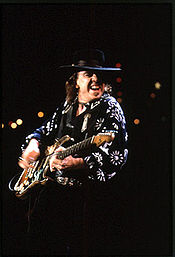
Texas blues guitarist,
Stevie Ray Vaughan
During the 1980s, blues also continued in both traditional and new forms. In 1986, the album Strong Persuader revealed Robert Cray as a major blues artist. The first Stevie Ray Vaughan recording Texas Flood was released in 1983, and the Texas based guitarist exploded onto the international stage. 1989 saw a revival of John Lee Hooker's popularity with the album The Healer. Eric Clapton known for his performances with the Blues Breakers and Cream, made a comeback in the 1990s with his album Unplugged, in which he played some standard blues numbers on acoustic guitar.
In the 1980s and 1990s, blues publications such as Living Blues and Blues Revue began to be distributed, major cities began forming blues societies, outdoor blues festivals became more common, and more nightclubs and venues for blues emerged.
In the 1990s, blues performers explored a range of musical genres, as can be seen, for example, from the broad array of nominees of the yearly Blues Music Awards, previously named W. C. Handy Awards or of the Grammy Awards for Best Contemporary and Traditional Blues Album. Contemporary blues music is nurtured by several blues labels such as: Alligator Records, Ruf Records, Chess Records (MCA), Delmark Records, NorthernBlues Music, and Vanguard Records (Artemis Records). Some labels are famous for their rediscovering and remastering of blues rarities such as Arhoolie Records, Smithsonian Folkways Recordings (heir of Folkways Records) and Yazoo Records (Shanachie Records).
Young blues artists today are exploring all aspects of the blues, from classic delta to more rock-oriented blues, artists born after 1970 such as Sean Costello, John Mayer, Anthony Gomes, Shemekia Copeland, Jonny Lang, Corey Harris, Susan Tedeschi, Joe Bonamassa, Michelle Malone, The White Stripes, North Mississippi Allstars, Gracie B, The Black Keys, Bob Log III, Jose P and Hillstomp developing their own styles. Memphis, Texas-based William Daniel McFalls, also known as "Blues Boy Willie" is a performer of traditional blues.
Musical impact
Blues musical styles, forms (12-bar blues), melodies, and the blues scale have influenced many other genres of music, such as rock and roll, jazz, and popular music. Prominent jazz, folk or rock performers, such as Louis Armstrong, Duke Ellington, Miles Davis, Bob Dylan and the White Stripes have performed significant blues recordings. The blues scale is often used in popular songs like Harold Arlen's "Blues in the Night", blues ballads like "Since I Fell for You" and "Please Send Me Someone to Love", and even in orchestral works such as George Gershwin's "Rhapsody in Blue" and "Concerto in F". Gershwin's second "Prelude" for solo piano is an interesting example of a classical blues, maintaining the form with academic strictness.
The blues scale is ubiquitous in modern popular music and informs many modal frames, especially the ladder of thirds used in rock music (e.g., in "A Hard Day's Night"). Blues forms are used in the theme to the televised Batman, teen idol Fabian's hit, "Turn Me Loose", country music star Jimmie Rodgers' music, and guitarist/vocalist Tracy Chapman's hit "Give Me One Reason".
R&B music can be traced back to spirituals and blues. Musically, spirituals were a descendant of New England choral traditions, and in particular of Isaac Watts's hymns, mixed with African rhythms and call-and-response forms. Spirituals or religious chants in the African-American community are much better documented than the "low-down" blues. Spiritual singing developed because African-American communities could gather for mass or worship gatherings, which were called camp meetings.
Early country bluesmen such as Skip James, Charley Patton, Georgia Tom Dorsey played country and urban blues and had influences from spiritual singing. Dorsey helped to popularize Gospel music. Gospel music developed in the 1930s, with the Golden Gate Quartet. In the 1950s, soul music by Sam Cooke, Ray Charles and James Brown used gospel and blues music elements. In the 1960s and 1970s, gospel and blues were these merged in soul blues music. Funk music of the 1970s was influenced by soul; funk can be seen as an antecedent of hip-hop and contemporary R&B.
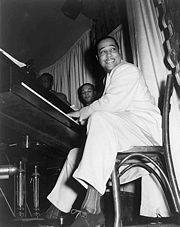
Duke Ellington straddled the big band and bebop genres.
Though Ellington was a jazz artist, he used the blues form extensively.
Before World War II, the boundaries between blues and jazz were less clear. Usually jazz had harmonic structures stemming from brass bands, whereas blues had blues forms such as the 12-bar blues. However, the jump blues of the 1940s mixed both styles. After WWII, blues had a substantial influence on jazz. Bebop classics, such as Charlie Parker's "Now's the Time", used the blues form with the pentatonic scale and blue notes. Bebop marked a major shift in the role of jazz, from a popular style of music for dancing, to a "high-art," less-accessible, cerebral "musician's music". The audience for both blues and jazz split, and the border between blues and jazz became more defined. Artists straddling the boundary between jazz and blues are categorized into the jazz-blues sub-genre.
The blues' twelve-bar structure and the blues scale was a major influence on rock-and-roll music. Rock-and-roll has been called "blues with a back beat". Carl Perkins called rockabilly "blues with a country beat". Rockabillies were also said to be twelve-bar blues played with a bluegrass beat. "Hound Dog", with its unmodified twelve-bar structure (in both harmony and lyrics) and a melody centered on flatted third of the tonic (and flatted seventh of the subdominant), is a blues song transformed into a rock-and-roll song. Jerry Lee Lewis's style of rock 'n' roll was heavily influenced by the blues and its derivative boogie woogie. His style of music was not exactly rockabilly but it has been often called real rock 'n' roll (this is a label he shares with several African American rock 'n' roll singers).
Early country music was infused with the blues. Jimmie Rodgers, Moon Mullican, Bob Wills, Bill Monroe and Hank Williams have all described themselves as blues singers and their music has a blues feel that is different to the country pop of Eddy Arnold. A lot of the 1970s-era "outlaw" country music by Willie Nelson and Waylon Jennings also borrowed from the blues. When Jerry Lee Lewis returned to country after the decline of 1950s style rock 'n' roll, he sang his country with a blues feel and often included blues standards on his albums. Many early rock-and-roll songs are based on blues: "That's All Right Mama", "Johnny B. Goode", "Blue Suede Shoes", "Whole Lotta Shakin' Goin On", "Shake, Rattle, and Roll", and "Long Tall Sally". The early African American rock musicians retained the sexual themes and innuendos of blues music: "Got a gal named Sue, knows just what to do" ("Tutti Frutti", Little Richard) or "See the girl with the red dress on, She can do the Birdland all night long" ("What'd I Say", Ray Charles).
In popular culture
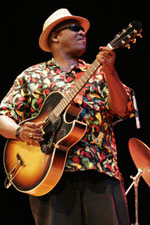
The music of Taj Mahal for the 1972 movie
Sounder marked a revival of interest in acoustic blues.
Like jazz, rock and roll, heavy metal music, hip hop music, reggae, country music, and pop music, blues has been accused of being the "devil's music" and of inciting violence and other poor behavior. In the early 20th century, the blues was considered disreputable, especially as white audiences began listening to the blues during the 1920s. In the early twentieth century, W.C. Handy was the first to popularize blues-influenced music among non-black Americans.
During the blues revival of the 1960s and '70s, acoustic blues artist Taj Mahal and legendary Texas bluesman Lightnin' Hopkins wrote and performed music that figured prominently in the popularly and critically acclaimed film Sounder (1972). The film earned Mahal a Grammy nomination for Best Original Score Written for a Motion Picture and a BAFTA nomination. Almost 30 years later, Mahal wrote blues for, and performed a banjo composition, claw-hammer style, in the 2001 movie release "Song Catcher," which focused on the story of the preservation of the roots music of Appalachia.
In 2003, Martin Scorsese made significant efforts to promote the blues to a larger audience. He asked several famous directors such as Clint Eastwood and Wim Wenders to participate in a series of documentary films for PBS called The Blues. He also participated in the rendition of compilations of major blues artists in a series of high-quality CDs. Grammy-winning blues guitarist and vocalist Keb' Mo' performed his blues rendition of "America, the Beautiful" in 2006 to close out the final season of the television series "The West
Musical style
During the first decades of the Twentieth Century, blues music was not clearly defined in terms of a chord progression. There were many blues in 8-bar form, such as "How Long Blues," "Trouble in Mind," and Big Bill Broonzy's "Key to the Highway." Idiosyncratic numbers of bars are also encountered occasionally, as with the 9-bar progression in Howlin' Wolf's "Sitting on Top of the World." The basic twelve-bar lyric framework of a blues composition is reflected by a standard harmonic progression of twelve bars in 4/4 or (rarely) 2/4 time. Slow blues are often played in 12/8 (4 beats per measure with 3 subdivisions per beat).
By the 1930s, twelve-bar blues became the standard. There would also be 16 bar blues, as in Ray Charles's instrumental "Sweet 16 Bars" and in Herbie Hancock's "Watermelon Man." The blues chords associated to a twelve-bar blues are typically a set of three different chords played over a twelve-bar scheme, refered to as a I, IV, V, or 1, 4, 5 progression such as E, A, B, or B7
A 12-bar blues is divided into three four-bar segments. A standard blues progression, or sequence of notes, typically features three chords based on the first (written as I), fourth (IV), and fifth (V) notes of an eight-note scale. The I chord dominates the first four bars; the IV chord typically appears in the second four bars (although in the example below, Elmore James introduces it in the first four bars); and the V chord is played in the third four bars.

The Roman numerals refer to the degrees of the progression. For example, if played in C, the chords would be as follows:

When the IV chord is played in bar 2, the blues is called a "Quick-Change" blues.
In this example, C is the tonic chord, F the subdominant. Much of the time, some or all of these chords are played in the harmonic seventh (7th) form. Frequently, the last chord is the dominant (V) turnaround, marking the transition to the beginning of the next progression. In this example, G/G7 is the turnaround.The use of the harmonic seventh interval is characteristic of blues and is popularly called the "blues seven". At a 7:4 ratio, it is not close to any interval on the conventional Western diatonic scale. Through convenience or necessity it is often approximated by a minor seventh interval or a dominant seventh chord. The lyrics generally end on the last beat of the tenth bar or the first beat of the eleventh bar, and the final two bars are given to the instrumentalist as a break; the harmony of this two-bar break, the turnaround, can be extremely complex, sometimes consisting of single notes that defy analysis in terms of chords. The final beat, however, is almost always strongly grounded in the dominant seventh (V7), to provide tension for the next verse.
In melody, blues is distinguished by the use of the flatted third, fifth and seventh of the associated major scale. These specialized notes are called the blue or bent notes. These scale tones may replace the natural scale tones, or they may be added to the scale, as in the case of the minor pentatonic blues scale, in which the flatted third replaces the natural third, the flatted seventh replaces the natural seventh and the flatted fifth is added between the natural fourth and natural fifth. While the twelve-bar harmonic progression had been intermittently used for centuries, the revolutionary aspect of blues was the frequent use of the flatted third, flatted seventh, and even flatted fifth in the melody, together with crushing—playing directly adjacent notes at the same time (i.e., diminished second)—and sliding, similar to using grace notes.
The blue notes allow for key moments of expression during the cadences, melodies, and embellishments of the blues. Where the three line verses end, for example, there is a falling cadence that approaches just shy of the tonic, combining the falling of a speaking voice with the shape of the blues scale in a unique, expressive way. This melodic fall, placed at the turnaround, is employed most clearly in the modern Chicago blues sound. A similar sound, melisma, occurs in gospel and R&B, but not to the same effect.
Whereas a classical musician will generally play a grace note distinctly, a blues singer or harmonica player will glissando, "crushing" the two notes and then releasing the grace note. In blues chord progressions, the tonic, subdominant and dominant chords are often played as harmonic seventh chords. While the harmonic seventh may be voiced easily on equally tempered instruments like the guitar, it is approximated by means of a minor seventh, which is a third of a semitone higher.) Blues is occasionally played in a minor key, such as in the style of Paul Butterfield. The scale differs little from the traditional minor, except for the occasional use of a flatted fifth in the tonic, often sung or played by the singer or lead instrument with the perfect fifth in the harmony. Janis Joplin's rendition of "Ball and Chain", accompanied by Big Brother and the Holding Company, provides an example of this technique. Minor-key blues is often structured in sixteen bars rather than twelve, in the style of gospel music, as in "St. James Infirmary Blues" and Trixie Smith's "My Man Rocks Me."
Blues shuffles reinforce the trance-like rhythm and call-and-response, and they form a repetitive effect called a groove. The simplest shuffles, used in many postwar electric blues, rock-and-rolls, or early bebops, were a three-note riff on the bass strings of the guitar. When this riff was played over the bass and the drums, the groove "feel" is created. The walking bass is another device that helps to create a groove. The last bar of the chord progression is usually accompanied by a turnaround.
Shuffle rhythm is often vocalized as "dow, da dow, da dow, da" or "dump, da dump, da dump, da", it consists of uneven, or "swung," eighth notes. On a guitar this may be played as a simple steady bass or it may add to that stepwise quarter note motion from the fifth to the sixth of the chord and back. An example is provided by the following guitar tablature for the first four bars of a blues progression in E.

Blues in jazz is much different from blues in other types of music. Jazz blues normally stays on the V chord through bars 9 and 10, emphasizing the dominant-tonic resolution over the subdominant-tonic structure of traditional blues. This final V-I cadence lends itself to many variations, the most basic of which is the ii-V-I progression in bars 9, 10 and 11. From that point, both the dominant approach (ii-V) and the resolution (I) can be altered and "substituted" in a variety of ways, even including abandonment of the I chord altogether (bars 9–12: ii | V | iii, vi | ii, V |). In this case, bars 11 and 12 function as an extended turnaround to the next chorus.
![]()
The History of : Blues | Country | Folk Music | Heavy Metal | Hip Hop | Jazz | Punk | Reggae | Rock n' Roll | Rockabilly
Piano | Guitar | Microphone |Drum
![]()
Aces and Eighths. A music resource site. Link To Us
Site Map ![]() Comments or Questions
Comments or Questions ![]() Submissions
Submissions ![]()
Privacy Policy

All text is available under the terms of the GNU Free Documentation License. (See Copyrights for details.
http://en.wikipedia.org/wiki/Blues
